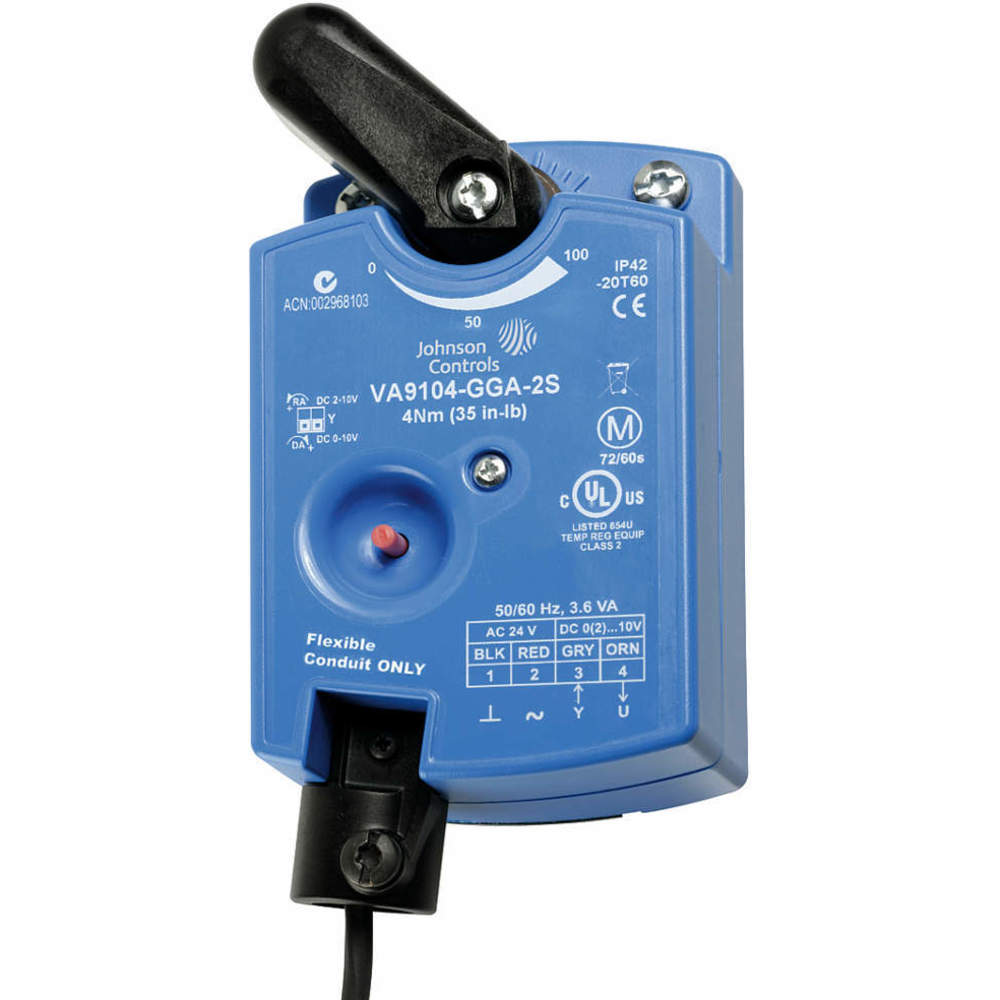Johnson Controls VA9104-GGA-2S electric valve actuator provides torque to operate a valve with the help of an electric motor. They are suitable for valve automation as they deliver higher torques than other conventional motors. This direct-mount, non-spring return electric valve actuator operates on 24 VAC power using robust asynchronous three-phase AC motors. Further, Johnson Controls VA9104-GGA-2S electric valve actuator is noiseless, energy-efficient and non-toxic. This Johnson Controls VA9104-GGA-2S electric valve actuator delivers a constant rotation irrespective of the high loads. It ensures a trouble-free service over the years with 100000 cycle ratings. Johnson Controls VA9104-GGA-2S electric valve actuator is installed with a single screw for direct & inexpensive mounting. It is further supplied with screw terminal electrical connections or plenum cables to make wiring fast and easy during ceiling plenum applications. The Johnson Controls VA9104-GGA-2S electric actuator permits manual positioning of the valve and can withstand temperatures up to 140 degrees Celsius.
Uses:
Electric actuators are primarily used in industrial applications associated with manufacturing pumps, valves and motors. Johnson Controls VA9104-GGA-2S electric actuator is used in wastewater treatment, power generation and pulp & paper plants, food & beverage industries, and farming & agricultural fields. It is suitable to automate valve closing and opening, thereby controlling plumbing fluid rates.
Working Mechanism:
An electric motor will produce rotary motion as the rotor or spindle rotates. The motor spindle is directly linked to a helical screw through the drive shaft that rotates the ball screw nut. As the spindle rotates, the ball screw nut gets driven in the forward & backward directions along the helical screw. A hollow piston rod is fixed to the ball screw nut, creating a linear motion into or out of the linear actuator. The motor is also controlled by an electric drive, allowing variation in the rotational and linear speeds of the actuator. A feedback mechanism provides positional information & the linear actuator is capable of being programmed to either move to a specified position, stop & move on, or come back to its static position.
Features:
- Johnson Controls VA9104-GGA-2S electric actuator is a direct-mount, non-spring return valve actuator that operates on 24V or 100 to 240V AC power.
- This Johnson Controls VA9104-GGA-2S electric actuator utilise the stepper motor or synchronous motor-driven actuators to provide precise positioning on the brand's VG1000 Series ball valves in HVAC applications.
- Johnson Controls VA9104-GGA-2S electric ball valve actuator delivers a running torque of 35 lb-inches (4 Nm).
- The nominal travel time of Johnson Controls VA9104-GGA-2S electric actuator is 60 seconds at 60 Hz for 90 degrees of rotation.
Compatible Accessories:
- Johnson Controls VA9104-GGA-2S electric actuator is compatible with M9000-551 mounting hardware replacement kits for controlling chilled water and hot water flow under normal equipment operating conditions.
Standards and Approvals:
- Johnson Controls VA9104-GGA-2S electric actuator is CE-compliant to deliver high-quality services and ensure user safety.
Installation:
Johnson Controls VA9104-GGA-2S electric actuator utilises a digital voltmeter or an M9000-200 commissioning tool for easy & secure installation.
Frequently Asked Questions:
Q. How is an AC two-position electric actuator wired?
A. The terminal strip of an AC two-position electric actuator connects the wires with various pins. Pin 1 is mostly the neutral line. Pin 2 and 3 act as the hotline for the open and closed positions. A relay like a control switch splits the hotline.
Q. What happens when an actuator fails?
A. An actuator failure could result in a hazardous spill, chemical release, explosion power loss, injury, property damage, environmental contamination or even loss of life. Actuators trigger an instant shutdown in case of an accident.
Q. Do you need to apply steady power to an electric actuator?
A. Either pins 1 & 3 or pins 1 & 2 will always have power. Limit switches cut the power supply to the motor when the actuator achieves the necessary position, open or closed.
Q. What are the differences between an electric and a pneumatic valve actuator?
A. The electric and pneumatic actuators differ from each other on the basis of the following factors:
- Power source: Pneumatic actuators depend on a compressed air line while electric actuators rely on an electric motor and the wiring for their operation.
- Speed: Electric actuators normally take up to or even more than 2 minutes for opening / closing a valve while pneumatic actuators can open or close a valve in 1/2 to 1/4 seconds, depending on the manufacturer.
- Durability: Both pneumatic & electric actuators can be used both outdoor & indoor units and can operate in extremely adverse environments.
- Temperature:. Electric actuators can be operated at temperatures ranging between 40 and 150 degrees F, whereas pneumatic actuators are rated for a higher temperature range of -20 to 350 degrees F.
- Cost: Pneumatic actuators are less expensive than electric actuators only when used for open & close operations, where modulation is not needed. Whereas with 4 - 20 control modulation, electric actuators have low cost than IP positioners on pneumatic actuators.
Q. Do we need a start capacitor and a brake on an electric actuator?
A. On an AC voltage electric actuator, a motor start capacitor is always needed to give the motor sufficient power to start. In the closed position, the energised brake keeps the motor in place. Without a mounted brake, especially on dampers and butterfly valves, there is a risk that the force exerted by the media within the pipes might push the valve, thus opening it slightly. The actuator detects the open valve and instantly rotates back so that the valve comes back to the completely closed position. This action repeats continuously as the media keep on pushing the valve open. Ultimately, this oscillation will damage the actuator and the motor.
 Change Country
Change Country



 Trade pricing is available for
Trade pricing is available for  Order Value should be £500+
Order Value should be £500+